Protection
against:
Overloads and short-circuits.
Cooling system inefficiency.
Loss of mains AC phase (phase control).
Excessive VSWR with real time automatic RF output power reduction
power in real time for excessive VSWR.
RF amplifier over drive.
Options:
Dual Drivers
Serial interface IEC 864-2
Stereo (IRT – NICAM – BTSC).
Dual Mains AC input line.
Interactive control with data storage (Data can be elaborated by PC).
Power amplifier
Thanks to the advanced MOSFET technology, the power amplifiers yield
high linearity, excellent efficiency and compact design. The two power
supplies are integrated into the amplifier module, which is an enclosed
unit.
The amplifier is equipped with one cooling system composed by two heath
dissipating fans that maintain constant 25°C ambient temperature
at the transistors junctions which normally operate up to 95°C
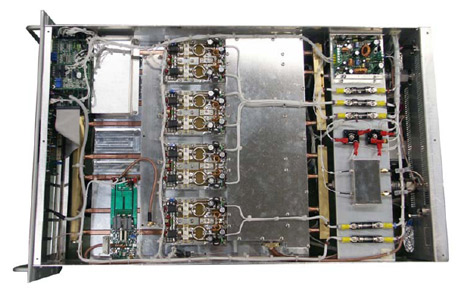
General characteristics
Very compact size: simplifies transportation and installation.
Modular design: increases reliability and simplifies maintenance and
operation.
Low operating cost. RF output obtained from the amplifiers modules in
parallel, each module with its own individual power supply to maximize
reliability.
High performance linearity corrector.
Very high MTBF. Full band coverage with broadband amplifiers requiring
no adjustments.
Signal is boosted to a power of approx. 3kW in the RF amplifier. The
amplifier is of modular design and contains four identical 800W base
modules.
RF output power is set and regulated by adjusting the drain voltage
of the amplifier output stages.
Filtration of the harmonics in the amplifier ensures a harmonics suppression
of more than 65dB.
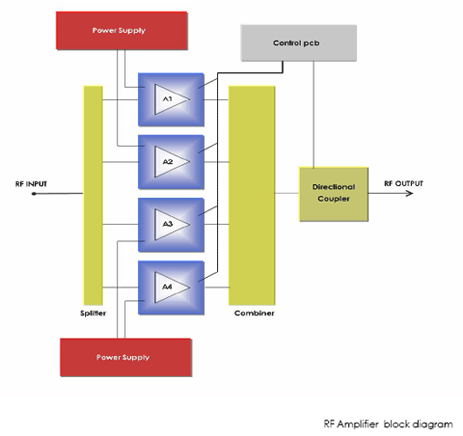
Touch
Screen Control Logic
The control logic allows full remote control capability thanks to the
microprocessor on the front panel control board: power output adjustment,
deviation adjustment, general on/off, alarm reset, forward and reverse
power measure, frequency deviation measure and alarm status are the
main functions of remote control function.
The display touch screen can change the colour depending on the operation
state of the equipment.
The colours are:
> Green perfect operation of the equipment
> Red generic alarm
> Orange Stand-by of the equipment
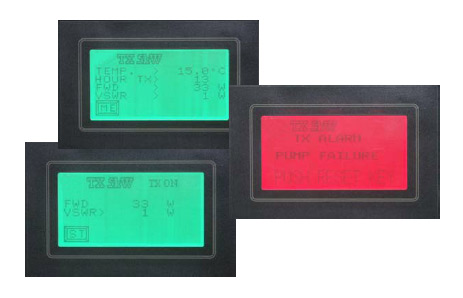
Operation mode
Automatic or Manual (Local or Remote)
Parallel interface according to IEC 864-1.
Serial interface RS232 or 485.
Options
Web server – TC/IP remote control
SMS remote control
TC/IP
WEB server (option) and SMS Remote Control (option).
Full monitoring and control of the equipment via Intranet or Internet
and via SMS message. It is possible to have a complete view of the status
of the equipment periodically or on request by a direct connection with
an Internet browser or sending a SMS.
The system automatically contacts via mail (fax) or via SMS the user
in case of alarm and can repeat the call more than one time as long
as its alarm status is present.
Password protection function to access the system: using this password
it is possible to access all the control functions of the equipment.
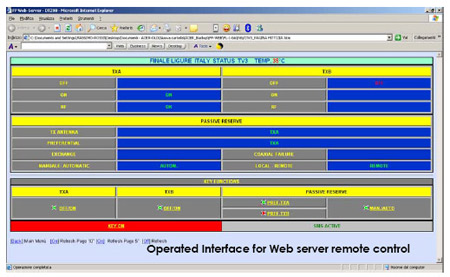
Comparison between liquid and air-cooling systems in solid-state
Broadcast Radio and FM Transmitters
The new generation transistors are becoming more and more powerful with
no change in dimensions. This, in turn, has generated the need for a
new and more powerful generation of cooling systems.
The traditional air cooling systems become insufficient at environment
temperatures >30°C To maintain satisfactory equipment temperatures,
the additional use of expensive and complicated systems of air conditioning
is required.
The most reliable and less expensive solution to this problem is ITEL
Telecommunication and Broadcasting Service new generation of liquid
coolers. The main substantial differences between liquid cooling and
air cooling are:
Longer device’s life ..
Liquid coolers ensure that even at environment temperatures as high
as 45°C, the devices flange temperature does not overcome the safety
limit of 55°C; this increases the device’s life.
Acoustic Noise. The absence of airflow inside the transmitter
cabinet and above all, the possibility of installing the liquid/air
heat exchangers away from the transmitters, allows for very low acoustic
noise generation.
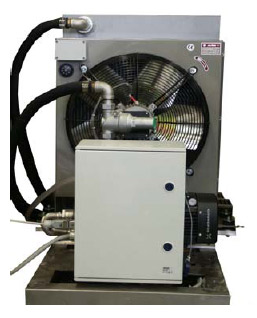 |
No
corrosion. The continuous presence 24/24 hours of forced
air on the electric and mechanic parts causes salty deposits and
corrosions that reduce the life of the parts. This corrosion is
avoided using the liquid cooling systems.
The liquid of cooling is normal water, not treated. The
hydraulic circuit has a capacity of about 30 litres (for a 10
kW radio): thanks to the closed circuit characteristics it only
requires the addition of 2 litres of water every six months. |
Operating Temperature. With the liquid cooling system,
an environmental temperature of up to 45°C is acceptable whereas
with the air-cooling system the maximum environmental temperature would
be 30°C. The liquid cooling systems, in fact, have a higher efficiency
in the transfer of heat.
Instant installation. It is not necessary to install
bulky air ducts at the input and output of the Amplifier cabinet. The
air/liquid heat exchanger can be easily placed outside the room where
the transmitter is installed and it is connected to it only with standard
flexible water’s pipes.
Radiation of heat into the environment.
Installing liquid cooling systems outside of the transmitter room, practically
eliminates environment heath radiation thus avoiding the cost of expensive
air conditioning systems.
 download
full specification
download
full specification